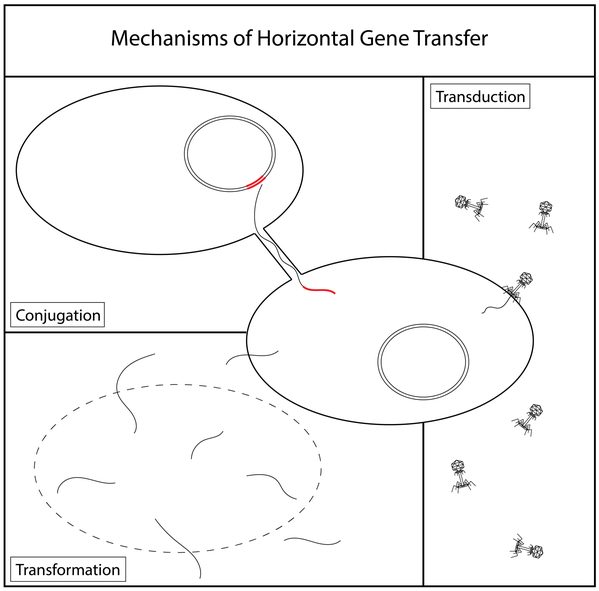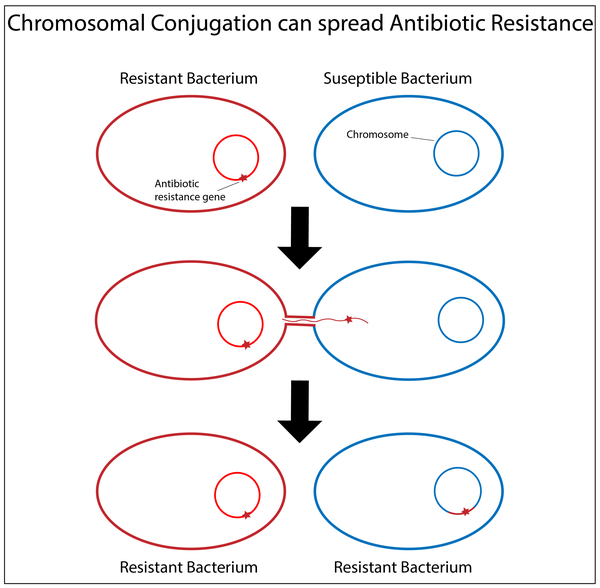Horizontal Gene Transfer & Antibiotic Resistance
Horizontal gene transfer (HGT) plays a major role in the both the general evolution of bacteria and specifically the spread of antibiotic resistance. HGT enables bacteria so spread genetic material not only to their offspring but to unrelated bacteria as well. The three main mechanisms in HGT are conjugation (both plasmid and chromosomal), transformation (the uptake of DNA from the environment) and phage mediated transduction. The most notorious and best studied player in the spread of antibiotic resistance are conjugative plasmids – extrachromosomal elements that are self-replicating and have the ability to transfer themselves quickly from one bacterium to another. However, in recent years, several globally prevalent multidrug-resistant clones of Enterobacteriaceae have emerged, that appear to have been formed by the acquisition of large fragments of genetic material being incorporated into the chromosome. The resulting strains show a mosaic genome with unique virulence and resistance properties. As of yet, very little is known about the mechanisms by which these clones could have emerged, their genetic architecture, whether the acquisition and incorporation of foreign genetic material is initially associated with a fitness cost, and whether it is possible to easily evolve an improved fitness phenotype that might support maintenance of the newly acquired genes.

This project therefore concerns itself with mechanisms and constrains on the transfer of chromosomal DNA – more specifically, the process of chromosomal conjugation and the resulting formation of hybrid bacterial genomes.
Project 1 – Genetic architecture and fitness of bacterial interspecies hybrids
For project I we are using chromosomal conjugation to construct hybrid strains of Escherichia coli and Salmonella enterica serovar Typhimurium. For paper I we have constructed strains were large section of foreign genetic material replace the bacteria’s original DNA and for paper II we have selected hybrid strains where the transferred foreign DNA is an addition to the existing bacterial chromosome. We are analyzing these strains regarding their genetic architecture and the constraints on mosaic formation. We also measure phenotypic features, including antibiotic resistance, relative fitness, genetic stability, and evolvability. After experimental evolution, we analyze the bacteria with mosaic chromosomes again regarding the rate and mechanisms of genetic adaptation in terms of their expression of resistance and relative fitness phenotypes.

Project II – Rapid spread of high-level fluoroquinolone resistance in clinical isolates
Where Project I concern itself more with the basic mechanisms of bacterial inter-species hybridization, Paper III will cover a more clinically relevant aspect of this process. In most clinical isolates, resistance to the fluoroquinolones – a highly effective group of antibiotics with a broad-spectrum – is gained through a step-wise acquisition of mutational changes in the fluoroquinolone target genes gyrA and parC, always requiring multiple generations of growths. Recently, however, an Escherichia coli sequence type, namely ST1193, was discovered, where these mutations appear to have been acquired in a single HGT event by the acquisition of chromosomal DNA from a distantly related Escherichia coli strain. For this project we have set up a system that allows us to transfer high-level fluoroquinolone resistance via chromosomal conjugation of the resistant target genes gyrA and parC. We are analysing the frequency with which these transfers happen between different strains/clinical isolates as well as the resistance phenotype, fitness and genetic architecture of the resulting hybrid strains.
Related published research
- Andersson, D. I. and D. Hughes (2010). "Antibiotic resistance and its cost: is it possible to reverse resistance?" Nat Rev Microbiol 8(4): 260-271.
- Brandis, G., S. Cao and D. Hughes (2018). "Co-evolution with recombination affects the stability of mobile genetic element insertions within gene families of Salmonella." Mol Microbiol 108(6): 697-710.
- Brandis, G. and D. Hughes (2020). "The SNAP hypothesis: Chromosomal rearrangements could emerge from positive Selection during Niche Adaptation." PLoS Genet 16(3): e1008615.
- Garoff, L., F. Pietsch, D. L. Huseby, T. Lilja, G. Brandis and D. Hughes (2020). "Population Bottlenecks Strongly Influence the Evolutionary Trajectory to Fluoroquinolone Resistance in Escherichia coli." Mol Biol Evol 37(6): 1637-1646.
- Hughes, D. (2000). "Co-evolution of the tuf genes links gene conversion with the generation of chromosomal inversions." J Mol Biol 297(2): 355-364.
